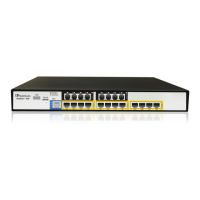• 480 (Temporarily Unavailable), 486 (User Busy), 488 (Not Acceptable Here) -
Due to incoming calls being preempted by another call.
The device receives SIP requests with preemption reason cause=5 in the following
cases:
• The softswitch performs a network preemption of an active call - the following
sequence of events occurs:
a. The softswitch sends the device a SIP BYE request with this Reason cause
code.
b. The device initiates the release procedures for the B-channel associated
with the call request and maps the preemption cause to PRI Cause = #8
‘Preemption’. This value indicates that the call is being preempted. For PRI,
it also indicates that the B-channel is not reserved for reuse.
c. The device sends a SIP 200 OK in response to the received BYE, before the
SIP end instrument can proceed with the higher precedence call.
• The softswitch performs a network preemption of an outbound call request for the
device that has not received a SIP 2xx response - the following sequence of
events occur:
a. The softswitch sends the device a SIP 488 (Not Acceptable Here) response
code with this Reason cause code. The device initiates the release
procedures for the B-channel associated with the call request and maps the
preemption cause to PRI Cause = #8 ‘Preemption’.
b. The device deactivates any user signaling (e.g., ringback tone) and when
the call is terminated, it sends a SIP ACK message to the softswitch.
28.12.2 Precedence Ring Tone
You can assign a ring tone that is defined in the CPT file to be played when a precedence
call is received from the IP side. This is configured by the PrecedenceRingingType
parameter. You can configure the duration for which the device plays a preemption tone to
the Tel and IP sides if a call is preempted, using the PreemptionToneDuration parameter.
Emergency Telecommunications Services (ETS) calls (e.g., E911) can be configured with
a higher priority than any MLPP call (default), using the E911MLPPBehavior parameter.
28.13 Denial of Collect Calls
You can configure the device to reject (disconnect) incoming Tel-to-IP collect calls and to
signal this denial to the PSTN. This capability is required, for example, in the Brazilian
telecommunication system to deny collect calls. When this feature is enabled upon
rejecting the incoming call, the device sends a sequence of signals to the PSTN. This
consists of an off-hook, an on-hook after one second, and then an off-hook after two
seconds. In other words, this is in effect, a double-answer sequence.
This feature can be enabled for all calls, using the EnableFXODoubleAnswer "global"
parameter, or it can be enabled for specific calls, by enabling this feature in a Tel Profile.
Notes:
• This feature is applicable only to FXO interfaces.
• If automatic dialing is also configured for an FXO port enabled with
Denial of Collect Calls, the FXO line does not answer the incoming call
(ringing) until a SIP 200 OK is received from the remote destination.
When a 200 OK is received, a double answer is sent from the FXO line.
• Ensure that the PSTN side is configured to identify this double-answer
signal.

